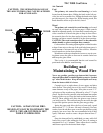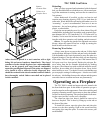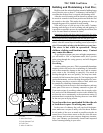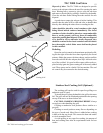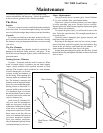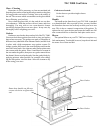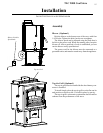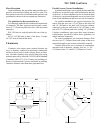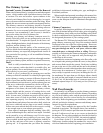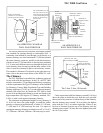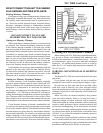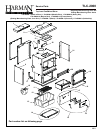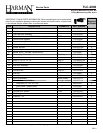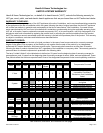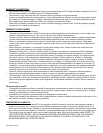17
When wood is burned slowly, it produces tar and other organic
vapors, which combine with expelled moisture to form soot
or creosote. The soot and creosote vapors condense in the
relatively cool chimney ue of a slow burning re. As a result,
soot or creosote residue accumulates on the ue lining. When
ignited, this soot or creosote can result in an extremely hot re.
The chimney connector and chimney should be inspected
at least once every two months during the heating season to
determine if a soot or creosote build-up has occurred. If soot
or creosote has accumulated (3 mm or more) it should be
removed to reduce the risk of a chimney re.
Checking your chimney and chimney connector more fre-
quently, especially while you are getting used to your stove,
is recommended. To inspect this system, let the stove cool.
Using a ashlight and mirror, check the interior of the chimney
connector, and the chimney itself.
To clean deposits from the surface of the connector, use a
stiff wire brush after dismantling the connector assembly. To
clean the chimney, use a specially designed brush sized to t
your particular ue opening, or call an established chimney
cleaning service.
At the end of the heating season, perform a thorough examina-
tion of your chimney system, and have it repaired if necessary.
Draft is widely misunderstood. It is important that you,
the stove operator, realize that draft is a variable effect, not
a given quantity. Stoves and chimneys do not have draft, yet
draft is the key to your stove’s performance.
Draft is a force, produced by an operating stove and the
chimney to which it is attached. It is created by hot gases rising
up the chimney, creating a pressure difference between the
inside of your home and the outside air. It continually moves
fresh combustion air into the stove, and hot exhaust gases out
of the stove; without this constant ow, the re will go out.
Other factors, such as barometric pressure, winds, the
airtightness of the home, the total inside chimney volume,
chimney height and the presence of venting devices such
as exhaust fans also play a role in maintaining an adequate
draft. In some cases, a window may need to be left open, or
some other source of fresh air provided, to keep the appli-
ance operating properly. Low barometric pressures, super
insulated homes and exhaust fans can reduce draft; winds can
play havoc with draft; and too large or too small a chimney
volume can cause reduced draft due to the excessive cooling
or not enough room to vent exhaust gases quickly.
Some signs of inadequate draft are smoking, odor, dif-
culty in maintaining the re, and low heat output. Overdraft
can be caused by a very tall chimney even if it is the recom-
mended size, and can cause overring of your stove. Signs
of an overdraft include rapid fuel consumption, inability to
slow the re, and parts of the stove or chimney connector
glowing red. It is important that you follow the chimney
guidelines in this manual, including size, type, and height to
avoid draft problems.
When installed and operated according to this manual, the
TLC 2000 will produce enough hot gases to keep the chimney
warm so that adequate draft is maintained throughout the
burn cycle.
In general, following these guidelines will ensure compli-
ance with all national and provincial codes; prior to beginning
your installation, check with your local building code ofcial
to check on additional local regulations which may inuence
the design and placement of your venting system.
The Harman TLC 2000 may be installed with (150 mm) 24
gauge chimney connector pipe. Size of the connector should
correspond to the size of the ue collar opening. Do not use
makeshift compromises.
Whenever
possible, avoid passing the connector through a combustible
wall; if you must, use an approved wall pass-through, de-
scribed later in this section.
Assemble the connector beginning at the ue collar, with
the crimped ends pointing towards the stove (to keep debris
and creosote akes inside the system). Each joint, including
the one to the stove’s ue collar and the one to the chimney
itself should be secured with at least three sheet metal screws.
Screws may be a maximum of 3 inches apart. A 1-1/4" (30
mm) overlap is required at each joint, including the ue col-
lar attachment. No more than two 90 degree elbows should
be used, and the total length of connector should not exceed
10 feet (3 m). All horizontal runs of connector must have a
minimum upward slope of 1/4"(6 mm) per foot (20 mm per
meter).
Occasionally it is necessary to pass the chimney connector
through a combustible wall to reach the chimney. Depending
on your local building codes, and the pertinent provincial or
national codes, there are several choices for accomplishing
this safely. Before beginning your installation, contact local
ofcials, and also the chimney connector and chimney manu-
facturer for specic requirements.
Canada. Three methods are approved by the Canadian
Standards Association. The diagram shows one method re-
quiring an 18"(450 mm) air space between the connector and
the wall. It allows use of one or two covers as described in
the diagram. The two other methods are described in detail in
the current issue of CAN/CSA B365, the national standard.
United States In the U.S., the national code is NFPA 211.
While many localities adopt this standard, be sure to check
with local authorities before beginning your installation.



